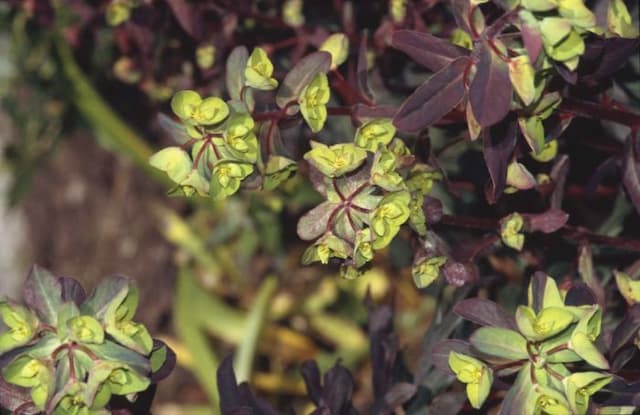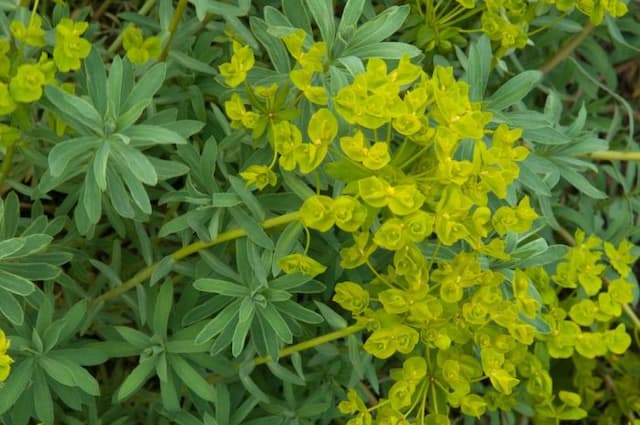Wood Spurge Euphorbia amygdaloides

ABOUT
The plant commonly known as wood spurge is a perennial with a bushy appearance. It has distinct evergreen leaves that are arranged in a spiraling pattern around its stems. These leaves are oblong to lance-shaped with pointed tips and take on a glossy, dark green color, which can add rich texture to garden spaces. During the spring months, wood spurge produces greenish-yellow flowers that are actually bracts, modified leaves that look like petals, surrounding the true flowers. These colorful bracts can add a bright and cheerful aspect to the plant's appearance. The true flowers are tiny and clustered within the center of the bracts, often going unnoticed due to their size and subtle appearance. The combination of the flowers and dark green leaves contrasts nicely and makes the wood spurge an attractive plant for gardeners. The stems of the plant are upright and bear the leaves and flowers, giving the plant a dense and clustered look.
About this plant
 Names
NamesFamily
Euphorbiaceae.
Synonyms
Wood Spurge, Amygdaloid Spurge, Woodland Spurge, Robb's Spurge.
Common names
Tithymalus amygdaloides, Euphorbia barrelieri, Euphorbia elliptica, Euphorbia heldreichii, Euphorbia lathyris, Euphorbia libanotica, Euphorbia viridiflora, Esula amygdaloides, Galarhoeus amygdaloides.
 Toxicity
ToxicityTo humans
Wood Spurge, the most common common name for Euphorbia amygdaloides, is toxic to humans. The plant contains a white, milky sap known as latex, which can cause skin irritation upon contact. If ingested, the sap can produce symptoms such as burning sensations in the mouth and throat, nausea, vomiting, and diarrhea. In some cases, ingestion can lead to more severe reactions, including swelling of the eyes and throat, difficulty breathing, and systemic reactions in individuals with latex allergies. It is important to avoid ingesting any part of this plant and to be cautious when handling it to prevent the sap from coming into contact with skin or mucous membranes.
To pets
The toxicity of Wood Spurge to pets is similar to its effects on humans. This plant should be considered toxic to pets, including cats and dogs. If a pet ingests any part of Wood Spurge, they could experience salivation, vomiting, diarrhea, and possibly more severe reactions if a large amount was consumed. The white, milky sap of the plant can also irritate the skin and mucous membranes upon contact. If you suspect your pet has ingested Wood Spurge, it is important to seek veterinary care immediately to manage the symptoms and prevent further complications.
 Characteristics
CharacteristicsLife cycle
Perennials
Foliage type
Evergreen
Color of leaves
Green
Flower color
Yellow
Height
1-2 feet [30-60 cm]
Spread
1-1.5 feet [30-45 cm]
Plant type
Shrub
Hardiness zones
6-9
Native area
Europe
Benefits
 General Benefits
General Benefits- Landscaping: Euphorbia amygdaloides, commonly known as wood spurge, is often used in gardens and landscape design due to its attractive foliage and structure.
- Drought Tolerance: As a hardy plant, wood spurge can withstand periods of drought once established, making it suitable for xeriscaping and low-water gardens.
- Year-Round Interest: With evergreen leaves and seasonal blooms, wood spurge provides visual interest throughout the year.
- Erosion Control: Its spreading habit and root system can help stabilize soil, making it useful for controlling erosion on slopes or in problem areas.
- Wildlife Support: The flowers can attract pollinators like bees, while the dense foliage can provide shelter for small garden fauna.
- Low Maintenance: Wood spurge typically requires minimal care, making it convenient for gardeners seeking low-effort plants.
- Shade Tolerance: It can thrive in shaded areas where other plants might struggle, allowing for gardening in a variety of light conditions.
 Medical Properties
Medical Properties- Emetic: Euphorbia amygdaloides, commonly known as wood spurge, has been used historically as an emetic to induce vomiting.
- Purgative: It has been utilized for its purgative properties, helping to clear the bowels.
- Diuretic: Wood spurge has been reported to have diuretic effects, assisting in the removal of excess water from the body.
- Topical use for skin conditions: In traditional medicine, the sap has been applied topically to treat warts and other skin growths.
 Air-purifying Qualities
Air-purifying QualitiesThis plant is not specifically known for air purifying qualities.
 Other Uses
Other Uses- Euphorbia amygdaloides, commonly known as Wood Spurge, can be used as a natural dye, giving a range of colors from yellow to brown, depending on the mordant used.
- The latex, or milky sap, of Wood Spurge has been historically used as a fish poison in small streams by some indigenous groups, a practice which is not legal or environmentally friendly.
- The robust and spreading nature of Wood Spurge makes it suitable for erosion control on banks and slopes where other plants might struggle to establish.
- As an ornamental plant, Wood Spurge can be used for creating contrast in rock gardens due to its evergreen foliage and unique flower structure.
- In floral arrangements, Wood Spurge can add an unusual green accent; however, caution is needed as the sap can cause skin irritation.
- Wood Spurge's tendency to grow in shady woodland areas can be harnessed to add greenery to challenging garden spots where sunlight is limited.
- Some gardeners use Wood Spurge as a companion plant to deter certain pests, benefiting nearby plants that are more prone to infestations.
- When landscaping for wildlife, Wood Spurge can provide shelter and habitat for a variety of insects and small animals due to its dense growth.
- The plant's resilience to deer browsing makes it a practical choice for gardens in areas where deer predation is a common problem.
- During the winter months, Wood Spurge maintains its greenery, offering a valuable source of winter interest in otherwise barren gardens.
Interesting Facts
 Feng Shui
Feng ShuiThe Wood Spurge is not used in Feng Shui practice.
 Zodiac Sign Compitability
Zodiac Sign CompitabilityThe Wood Spurge is not used in astrology practice.
 Plant Symbolism
Plant Symbolism- Persistence: Euphorbia amygdaloides, commonly known as Wood Spurge, has the ability to thrive in challenging conditions, often symbolizing determination and the endurance to persist through adversity.
- Protection: The milky sap of Wood Spurge is toxic, which can symbolize protection and defense against harm.
- Healing: Traditionally, some species of Euphorbia were used for medicinal purposes, although this should be approached with caution. Wood Spurge therefore can represent healing, both physical and emotional.
 Water
WaterThe wood spurge, or Euphorbia amygdaloides, prefers consistent moisture but does not do well sitting in waterlogged soil. Water the plant deeply and allow the top inch of the soil to dry out before watering again. In general, this might mean watering the plant every 1-2 weeks, but this can vary based on climate and indoor conditions. Provide about half a gallon of water for an average-sized plant each time you water, adjusting for the size of your plant and growing conditions. During the winter months, reduce the frequency of watering as plant growth slows down.
 Light
LightWood spurge thrives best in partial to full sunlight. Place the plant in a location where it can receive several hours of direct sunlight but is protected from the harsh midday sun, which can be too intense. A spot that gets morning sunlight and afternoon shade would be ideal for Euphorbia amygdaloides.
 Temperature
TemperatureWood spurge is tolerant of a wide range of temperatures and can survive in conditions as low as 30°F and as high as 90°F. The ideal temperature range for Euphorbia amygdaloides is between 60°F and 75°F. Make sure to protect the plant from extreme temperatures, as prolonged exposure to conditions outside of its tolerance range can harm it.
 Pruning
PruningPrune the wood spurge to remove any dead or damaged stems and to shape the plant as needed. Euphorbia amygdaloides benefits from occasional pruning to promote bushier growth and remove any spent flowers. The best time to prune is in late winter or early spring before new growth begins. Prune the plant every year or two to maintain its size and appearance.
 Cleaning
CleaningAs needed
 Soil
SoilWood Spurge, or Euphorbia amygdaloides, thrives in well-draining soil that is rich in organic matter. Ideal pH for Wood Spurge ranges from neutral to slightly alkaline, around 6.5 to 7.5. A suitable soil mixture would be one part garden soil, one part peat or leaf mould, and one part perlite or coarse sand to ensure proper drainage.
 Repotting
RepottingWood Spurge, also known as Euphorbia amygdaloides, should be repotted every two to three years to replenish the soil and to accommodate the growth of the plant. This time frame can vary depending on the growth rate and size of the plant.
 Humidity & Misting
Humidity & MistingWood Spurge, the common name for Euphorbia amygdaloides, prefers a moderate humidity level, typical of the average room environment. It is not demanding in terms of humidity and can tolerate some dry air, but avoid placing it near heating sources.
 Suitable locations
Suitable locationsIndoor
Place in bright, indirect light with some direct sun.
Outdoor
Plant in partial shade; protect from extreme cold.
Hardiness zone
6-9 USDA
 Life cycle
Life cycleWood Spurge (Euphorbia amygdaloides) begins its life cycle as seeds, which germinate in early spring when soil temperatures and moisture levels are adequate. The seedlings emerge and develop into juvenile plants, producing a rosette of leaves close to the ground. As they mature, they form upright stems and grow to their full height, which can be up to 80 centimeters, producing characteristic greenish-yellow flowers in late spring to early summer. After pollination, typically by insects, the flowers develop into fruit capsules containing seeds, which burst open when ripe to disperse seeds. The plant usually enters a dormant phase in winter, with the above-ground parts dying back, to re-emerge in the following spring. Wood Spurge is a perennial herbaceous plant, meaning it can live for several years, going through the cycle of growth, flowering, seed production, and dormancy annually.
 Propogation
PropogationPropogation time
Spring-Early Summer
Wood Spurge, or Euphorbia amygdaloides, is commonly propagated through seed or division. The most popular method is division, which is typically done in the spring or fall. To propagate by division, carefully lift the plant from the soil, making sure to keep a good amount of roots intact. Then, using a sharp knife or spade, divide the root ball into smaller sections, each with several shoots and a portion of the root system. These sections can then be immediately replanted in well-draining soil, spaced adequately apart. Water the newly planted divisions well to help establish their root systems. It's important to handle the plant with care as its sap can be a skin irritant.









